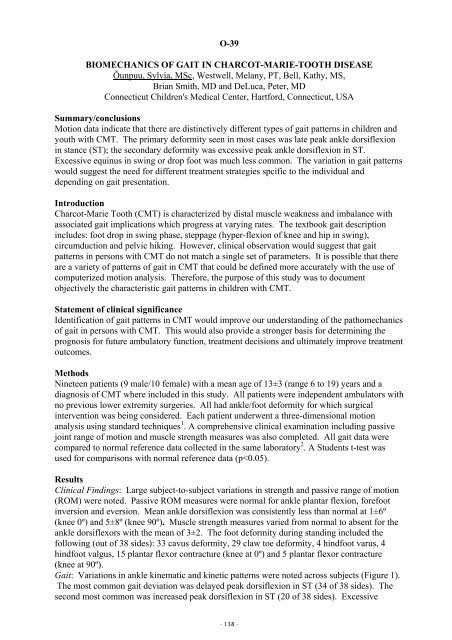1st Joint ESMAC-GCMAS Meeting - Análise de Marcha
1st Joint ESMAC-GCMAS Meeting - Análise de Marcha
1st Joint ESMAC-GCMAS Meeting - Análise de Marcha
Create successful ePaper yourself
Turn your PDF publications into a flip-book with our unique Google optimized e-Paper software.
O-39<br />
BIOMECHANICS OF GAIT IN CHARCOT-MARIE-TOOTH DISEASE<br />
Õunpuu, Sylvia, MSc, Westwell, Melany, PT, Bell, Kathy, MS,<br />
Brian Smith, MD and DeLuca, Peter, MD<br />
Connecticut Children's Medical Center, Hartford, Connecticut, USA<br />
Summary/conclusions<br />
Motion data indicate that there are distinctively different types of gait patterns in children and<br />
youth with CMT. The primary <strong>de</strong>formity seen in most cases was late peak ankle dorsiflexion<br />
in stance (ST); the secondary <strong>de</strong>formity was excessive peak ankle dorsiflexion in ST.<br />
Excessive equinus in swing or drop foot was much less common. The variation in gait patterns<br />
would suggest the need for different treatment strategies spcific to the individual and<br />
<strong>de</strong>pending on gait presentation.<br />
Introduction<br />
Charcot-Marie Tooth (CMT) is characterized by distal muscle weakness and imbalance with<br />
associated gait implications which progress at varying rates. The textbook gait <strong>de</strong>scription<br />
inclu<strong>de</strong>s: foot drop in swing phase, steppage (hyper-flexion of knee and hip in swing),<br />
circumduction and pelvic hiking. However, clinical observation would suggest that gait<br />
patterns in persons with CMT do not match a single set of parameters. It is possible that there<br />
are a variety of patterns of gait in CMT that could be <strong>de</strong>fined more accurately with the use of<br />
computerized motion analysis. Therefore, the purpose of this study was to document<br />
objectively the characteristic gait patterns in children with CMT.<br />
Statement of clinical significance<br />
I<strong>de</strong>ntification of gait patterns in CMT would improve our un<strong>de</strong>rstanding of the pathomechanics<br />
of gait in persons with CMT. This would also provi<strong>de</strong> a stronger basis for <strong>de</strong>termining the<br />
prognosis for future ambulatory function, treatment <strong>de</strong>cisions and ultimately improve treatment<br />
outcomes.<br />
Methods<br />
Nineteen patients (9 male/10 female) with a mean age of 13±3 (range 6 to 19) years and a<br />
diagnosis of CMT where inclu<strong>de</strong>d in this study. All patients were in<strong>de</strong>pen<strong>de</strong>nt ambulators with<br />
no previous lower extremity surgeries. All had ankle/foot <strong>de</strong>formity for which surgical<br />
intervention was being consi<strong>de</strong>red. Each patient un<strong>de</strong>rwent a three-dimensional motion<br />
analysis using standard techniques 1 . A comprehensive clinical examination including passive<br />
joint range of motion and muscle strength measures was also completed. All gait data were<br />
compared to normal reference data collected in the same laboratory 2 . A Stu<strong>de</strong>nts t-test was<br />
used for comparisons with normal reference data (p
















